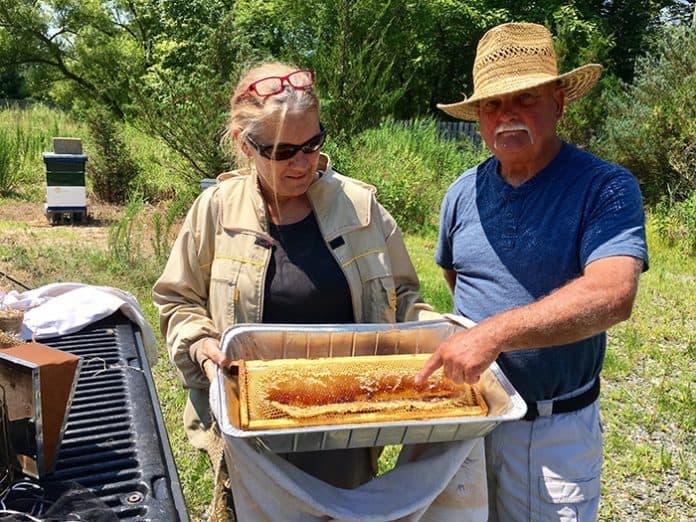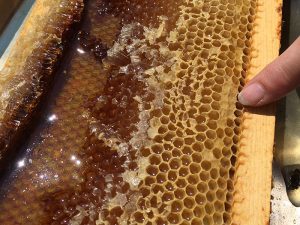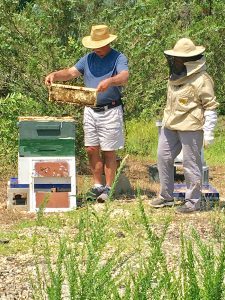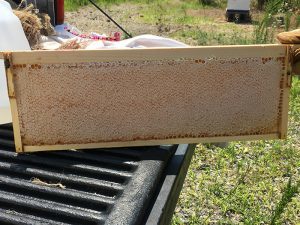
BRICK – Cliff Brown carefully lifted the outer cover of the beehive and tapped it on the ground to knock the honeybees off from the inside.
“If I don’t knock them off, they’ll get squashed when I put the cover back on,” said Brown, 65. He wanted to check on the hive, so he lifted out one of the frames, which was swarming with worker bees. Although he’s been stung multiple times in the past, Brown wears no protective clothing.
Brown has taken up the hobby of beekeeping since he retired from the Brick Police Department in 2011, where he was a police officer for 25 years. His wife, Lorraine, 63, fully supports her husband’s interest, although she does wear protective clothing while checking on their hives.

He said he’d always had a passing interest in beekeeping, but he never acted on it until four years ago when he saw a magazine article on beekeeping while he was waiting in his dentist’s office.
“It piqued my interest when it said how you can raise them in your backyard,” Brown recalled of the article.
“We had a good-sized backyard, so we knew we could do it,” added Lorraine.
So, in 2013, the couple ordered a starter kit – or a “nuke kit” – that comes with everything needed to start a hive, including a mated queen; five frames that fit into a wooden hive (that Brown built himself); and a mixed brood of larvae bees in cells. The starter kits cost anywhere from $150 to $175.
Now, four years later, the Browns have about a dozen hives: they keep six on private property off Mantoloking Road; five on private property in Jackson; and one at their residence in Cherry Quay.
It has been a learning experience for the couple, who have educated themselves and joined others with the same interest at the NJ Beekeeper’s Association, which regularly hosts lectures on beekeeping.
Everything a beekeeper needs is available for purchase online, from the boxes used in hives, which come in several sizes and hold different populations of honeybees; to a queen, who comes in a box packed with syrup that keeps her alive.
The Browns learned that the queen has to take flight to find drones to mate with (she won’t mate with drones from her own hive), and then she comes back to the hive and never leaves again, storing the sperm and spending her entire two- to five-year lifecycle in the hive, laying up to 1,200 eggs (or her own bodyweight in eggs) a day.

The drones, or male honeybees, do nothing in the hive. They don’t work, they don’t sting, they just suck up all the honey and they usually get thrown out of the hive by the other bees during the dormant winter period, Lorraine said.
There are two kinds of frames in a hive: one is for honey, and one is for brood. The worker bees forage up to three miles away from the hive for nectar and pollen from flowering plants, and their bodies break down the nectar down and store it into a honeycomb cell. Then they beat their wings over the honeycomb-shaped cell to fan out the moisture and cap it with beeswax.
The cells in a beehive look different for each type of bee. The drone cells, which hatch in 14 days, have a hump or a bullet head shape. Once the drones mate, they die. The worker bee cells, which hatch in 12 days, are flat. Worker bees live for 40 days. The queen cells are peanut-shaped and hang down from the frame, Lorraine said.
“Once they hatch, they do their job,” explained Cliff. “Worker bees have stages: when they’re first born, they are nurse bees, they tend to new bees and the queen. Then they’re forage bees, who collect pollen and water in sacs on their legs,” he said.
“They like to find flowers where they can land on the leaves,” Cliff said. “I’ve noticed that sometimes they prefer different flowers at different times of the day.”
Each of the hives contain 20,000 to 60,000 honeybees, and they have the potential of producing 120 pounds of honey each year. One gallon of honey weighs about 11 pounds.
“The queen looks like a honeybee, but she’s a little bit longer; you can buy a queen separately, which you would do to replace a queen, or if you want to split a strong hive,” Cliff explained.
The queen lets you know the hive has gotten too crowded, Lorraine explained.
“It’s nature’s way of creating a new hive. The queen tells the bees to swarm, or to leave the hive. She’ll take half the population with her after sending scouts out to find a new place,” she said. “I don’t know how they convey it, but the scouts come back after finding a new place, and half of them fly away.”
Meanwhile, the queen has left behind queen eggs, for which the worker bees have prepared cells where the eggs can grow to replace the departed queen.

Each hive can have a different temperament, Cliff said. Some say that the queen sets the temperament for the hive, he added.
The Browns check on their hives about once every ten days. Cliff doesn’t get stung much these days since he’s learned how to handle the bees, but he has been stung multiple times in the past.
“That was after you aggravated them,” Lorraine said.
Bees release alarm pheromones when they sting, which cause other bees to behave defensively, i.e. to sting or charge, Cliff said. To avoid such episodes, they use a smoker to calm the bees before they open the hive.
“There’s a theory that the bees think there’s a fire, so they go inside the hive to protect their stores and brood,” Lorraine said.
Cliff checks for problems, such as diseases or invasive parasites, like hive beetles or wax moths. They also check to see the honey production, if the cells have been capped, and the level of sugar water, which they pour into a container in the hive that helps bees to produce wax.
“It’s a learning process. We have one state apiarist, Tim Schuler, who comes to look at the hives for us when there’s a problem,” he said.
According to the Environmental Protection Agency, honeybee colonies have been declining since the 1990s because of pesticides used in industrial agriculture, climate change, and pathogens/parasites, especially the invasive varroa mite.
The phenomenon is called “Colony Collapse Disorder,” (CCD) which occurs when most of the worker bees in a colony disappear and leave behind a queen, plenty of food and a few nurse bees to care for the remaining immature bees and the queen.
“The mites proliferate in hives. They attach to the bees, and in the 1980s they had no way to control them, but now there is medication that kills the mites,” Cliff said.

According to the EPA, honeybees have been making a comeback, with reports of CCD declining substantially over the last five years.
A third of food production depends on bees and other pollinating insects, which play an essential role in ecosystems.
The Browns collect honey from their hives once or twice a year, depending on several variables, such as how flowering plants have done based on weather conditions.
Once the individual honeycomb-shaped cells are filled with honey, the bees cap them with wax. The Browns use a special knife to scrape the wax off, and then they put the frame, standing-up, in a bucket spinner that uses centrifugal force to extract the honey.
The honey goes to the bottom of the tub where it comes out a spout into a metal strainer that filters out any bee parts and wax, and then the honey gets jarred.
This year they produced about 10 gallons. Eventually the couple hopes to have 20 hives and start selling the honey, although gone are the days of backyard beekeeping.
“Everybody wants bees around, but not around them,” Cliff said.






